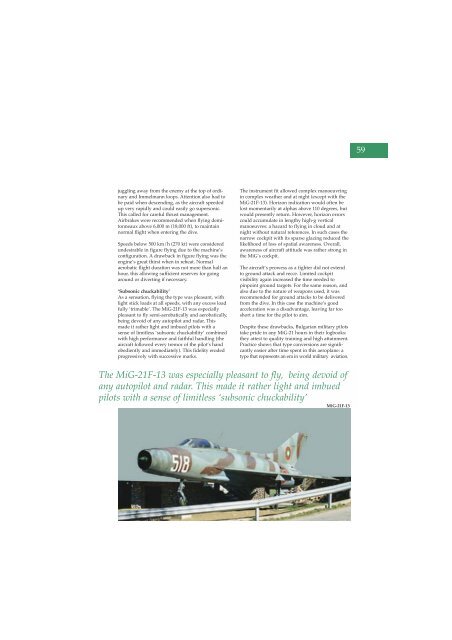Volume 6 No 4 - Royal Air Force Centre for Air Power Studies
Volume 6 No 4 - Royal Air Force Centre for Air Power Studies
Volume 6 No 4 - Royal Air Force Centre for Air Power Studies
You also want an ePaper? Increase the reach of your titles
YUMPU automatically turns print PDFs into web optimized ePapers that Google loves.
59<br />
juggling away from the enemy at the top of ordinary<br />
and Immelmann loops. Attention also had to<br />
be paid when descending, as the aircraft speeded<br />
up very rapidly and could easily go supersonic.<br />
This called <strong>for</strong> careful thrust management.<br />
<strong>Air</strong>brakes were recommended when flying demitonneaux<br />
above 6,000 m (18,000 ft), to maintain<br />
normal flight when entering the dive.<br />
Speeds below 500 km/h (270 kt) were considered<br />
undesirable in figure flying due to the machine’s<br />
configuration. A drawback in figure flying was the<br />
engine’s great thirst when in reheat. <strong>No</strong>rmal<br />
aerobatic flight duration was not more than half an<br />
hour, this allowing sufficient reserves <strong>for</strong> going<br />
around or diverting if necessary.<br />
‘Subsonic chuckability’<br />
As a sensation, flying the type was pleasant, with<br />
light stick loads at all speeds, with any excess load<br />
fully ‘trimable’. The MiG-21F-13 was especially<br />
pleasant to fly semi-aerobatically and aerobatically,<br />
being devoid of any autopilot and radar. This<br />
made it rather light and imbued pilots with a<br />
sense of limitless ‘subsonic chuckability’ combined<br />
with high per<strong>for</strong>mance and faithful handling (the<br />
aircraft followed every tremor of the pilot’s hand<br />
obediently and immediately). This fidelity eroded<br />
progressively with successive marks.<br />
The instrument fit allowed complex manoeuvring<br />
in complex weather and at night (except with the<br />
MiG-21F-13). Horizon indication would often be<br />
lost momentarily at alphas above 110 degrees, but<br />
would presently return. However, horizon errors<br />
could accumulate in lengthy high-g vertical<br />
manoeuvres: a hazard to flying in cloud and at<br />
night without natural references. In such cases the<br />
narrow cockpit with its sparse glazing reduced the<br />
likelihood of loss of spatial awareness. Overall,<br />
awareness of aircraft attitude was rather strong in<br />
the MiG’s cockpit.<br />
The aircraft’s prowess as a fighter did not extend<br />
to ground attack and recce. Limited cockpit<br />
visibility again increased the time needed to<br />
pinpoint ground targets. For the same reason, and<br />
also due to the nature of weapons used, it was<br />
recommended <strong>for</strong> ground attacks to be delivered<br />
from the dive. In this case the machine’s good<br />
acceleration was a disadvantage, leaving far too<br />
short a time <strong>for</strong> the pilot to aim.<br />
Despite these drawbacks, Bulgarian military pilots<br />
take pride in any MiG-21 hours in their logbooks:<br />
they attest to quality training and high attainment.<br />
Practice shows that type conversions are significantly<br />
easier after time spent in this aeroplane: a<br />
type that represents an era in world military aviation.<br />
The MiG-21F-13 was especially pleasant to fly, being devoid of<br />
any autopilot and radar. This made it rather light and imbued<br />
pilots with a sense of limitless ‘subsonic chuckability’<br />
MiG-21F-13
















